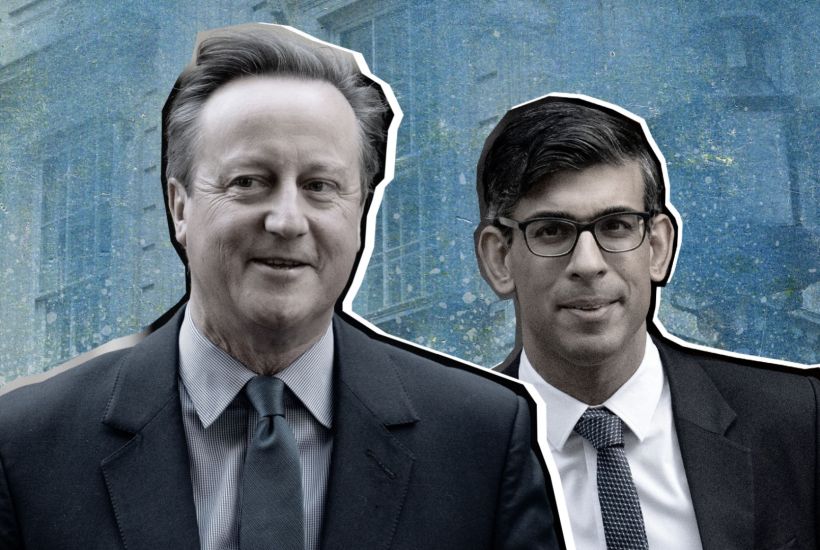When David Cameron arrived at the Foreign Office on Monday, he told staff he might be a bit rusty when it comes to modern politics. He joked that the only WhatsApp group he is in ‘is to do with my children’s school play’. Cameron may have been out of frontline politics for a while, but the rules stay the same. As Tory leader, he championed his favourites and promoted his supporters to the cabinet table, even at the expense of ignoring older colleagues’ claims. This week, his successor has done the same.
A trio of thirtysomething former special advisers elected in 2019 now comprise the Prime Minister’s Praetorian Guard. Laura Trott, 38, the former pensions minister, is the chief secretary to the Treasury. Like Sunak’s deputy, Oliver Dowden, Trott worked as an adviser in Cameron’s No. 10. She also co-authored the party’s 2015 manifesto. That campaign inspires members of Sunak’s team, who hope to recreate its success next year.
There are echoes of 2014, when Cameron used fresh faces incabinet to front his campaign
Richard Holden, also 38, is the new party chairman. He is a proud grammar schoolboy and a CCHQ man to his core. Holden is another veteran of the Cameron years, having worked in the teams which won the 2010 and 2015 elections. ‘A real operator,’ in the words of one MP. Holden led the ‘beergate’ attack on Keir Starmer last year, which prompted Durham Police’s investigation into alleged lockdown breaches. He currently sits for North West Durham, a Red Wall marginal with a majority of 1,144. He is, however, seeking a new berth elsewhere: a task that will be easier in his new role as chairman. ‘Finding him a safer seat ought not to be a problem,’ remarks one colleague, dryly.
Trott and Holden join a third recent addition to the cabinet: Claire Coutinho, the Energy Secretary. She was the first of her 2019 intake to obtain ministerial rank. So rapid was her rise that she reached the top table of British politics even before this week’s reshuffle. Coutinho, also 38, served as Sunak’s spad before she was elected and is seen as the Prime Minister’s closest cabinet colleague.
The rise of Trott, Holden and Coutinho represents the Rishification of the Tory party – 14 months ago, all three were on the backbenches. Their promotion comes at the expense of the other Tory tribes within government: there are three times as many Sunak supporters in cabinet as there are those who backed Liz Truss for the leadership last summer. And like the Prime Minister, more than half went to Oxbridge, while nearly two thirds also attended private schools.
A fourth name can be added to this list of Sunakites: Victoria Atkins, the Health Secretary. Atkins is the daughter of the former Tory MP Robert Atkins. She shares her father’s One Nation politics, and Sir John Major is a family friend. Atkins is an ex-criminal barrister who was elected in 2015 and, like Coutinho, she was the first of her intake to become a minister, taking up the safeguarding brief at the Home Office in 2017. Under Boris Johnson, her prospects stalled. She quit his government after the Chris Pincher scandal, alongside Sunak, Coutinho and Trott. As Health Secretary, her first few months in office are likely to be dominated by tales of deadly ambulance delays and elderly patients stuck for hours on trolleys in A&E.
The lower rungs of government contain interesting appointments, too. Laura Farris is a staunch One Nation Tory who previously worked for Hillary Clinton and now sits for her father’s old seat of Newbury. In July, she gave an impassioned speech in support of the Privileges Committee Inquiry into Johnson. Her reward is challenging: she’s straddling the Justice and Home Office briefs. Lee Rowley, meanwhile, whose triumph in North East Derbyshire six years ago was a precursor to the Red Wall gains of 2019, has been given the role of the 16th housing minister in 13 years of Tory government.
All the aforementioned are skilled media performers who have proven their worth to No. 10 behind the scenes and on the airwaves. Their appointments signal a shift within government away from delivery and towards campaigning, as an election is expected within a year. ‘The civil service will drag their feet on anything you do,’ grumbles one MP. ‘There’s not much left that we can do which will be felt on the ground before polling day,’ adds an aide in a big-spending department. ‘It’s now about which messengers are best.’ There are echoes of 2014, when Cameron used the fresh faces in his cabinet to front his campaign, even if that meant punishing effective ministers, such as Michael Gove, who polled badly with the public.
Outwardly, all efforts are focused on winning the election. Inevitably, however, some are thinking of what may come afterwards. Should Sunak pull off an improbable victory, his vindicated allies would emerge strengthened. Defeat, though, looks much more likely. Polls point to the Tories holding somewhere between 150 and 200 seats. ‘I think we will be teetering around the low hundred mark,’ admits one gloomy Sunak supporter. A landslide loss, however catastrophic, would not necessarily lead to a corresponding wipeout of Sunak’s allies. Trott, Coutinho and Atkins are all in seats with majorities of more than 24,000.
Indeed, research by Tim Bale, a professor of politics at Queen Mary University of London, and David Jeffery, a senior lecturer at Liverpool University, suggests that the MPs who backed Sunak in last year’s Tory leadership contest would be disproportionately represented among the survivors in the aftermath of a landslide defeat.
Should Sunak lose and then quit, it will be these MPs who choose which candidates face the membership to replace him. Amid much talk of a ‘lurch to the right’ after next year’s election, it is quite plausible that the final candidates will be two members of Sunak’s cabinet. Johnson was the exception to the rule when he won the leadership contest from the backbenches. It is much more common for a well-placed cabinet member, biding their time, to seize the crown.
As Cameron surveys his colleagues from his place at the cabinet table beside his onetime lieutenant, Dowden, he can reflect on how the Tories have changed since his tenure – and how much remains the same. He was the future once; they are the future now.
Got something to add? Join the discussion and comment below.
Get 10 issues for just $10
Subscribe to The Spectator Australia today for the next 10 magazine issues, plus full online access, for just $10.
You might disagree with half of it, but you’ll enjoy reading all of it. Try your first month for free, then just $2 a week for the remainder of your first year.









Comments
Don't miss out
Join the conversation with other Spectator Australia readers. Subscribe to leave a comment.
SUBSCRIBEAlready a subscriber? Log in